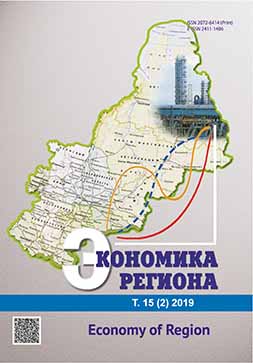ОЦЕНКА ДАННЫХ О ДОХОДАХ НАСЕЛЕНИЯ В РЕГИОНАЛЬНОМ РАЗРЕЗЕ МЕТОДОМ ГЛАВНЫХ КОМПОНЕНТ
Analysing the Data on Incomes in the Regional Context by the Principal Component Method
Author(s): Baryy Galeevich Ilyasov, Elena Anatolyevna Makarova, Elena Shavkatovna Zakieva, Emma Salavatovna GizdatullinaSubject(s): National Economy, Labor relations, Socio-Economic Research
Published by: Институт экономики Уральского отделения Российской академии наук
Keywords: population income; principal component method; sample; clustering; weight coefficient; coefficient of information content; integrated sign; scatterplot; clusters of regions; imitating dynamic model;
Summary/Abstract: The article focuses on solving the task of analysing statistical data on households’ income and their main components in absolute and relative units. We took into account a number of additional indicators, including social transfers, and applied the principle component method. The analysis’ purpose was to identify patterns of «clustering». The first step was to identify clusters of the Russian Federation regions, which vary in terms of population’s revenue structure taking into account the volumes of subsidies and subventions. The second step was to determine the generalized characteristics of the revealed clusters and their representation in a form of clustering rules. We have shown that the cluster structure of the households sector at the regional level is sufficiently polarized. We have revealed the small clusters of regions characterized by a high level of households’ monetary income and relatively large population (e. g. Moscow, Khanty-Mansi Autonomous Okrug). Alternatively, there are sufficiently inhabited clusters of regions with both a considerable volume of non-monetary income in a form of food combined and the low or average level of monetary income and small positive dynamics of population (Bryansk, Kursk Oblasts). On the other hand, in the regions with a relatively low monetary income, the revenue structure includes a high share of natural supplies in the form of food(for example, Republic of Dagestan and Republic of Ingushetia). Moreover, in the regions with a high monetary income, there is a small share of the raised funds and spent savings in revenue structure (Yamalo-Nenets Autonomous Okrug and others).We have constructed clusters of regions and established their quantity, structure and generalized characteristics presented in the form of clustering rules. We used that data for defining structural and parametrical characteristics when developing a dynamic model of the households sector and the module of intellectual management. These dynamic model and the module became a part of the system of imitating dynamic modelling and intellectual management (SIDMIM) of population income generation. The application of SIDMIM involves scenario studies for decision-making in managing the population income at the regional level considering differentiation in the income level.
Journal: Экономика региона
- Issue Year: 15/2019
- Issue No: 2
- Page Range: 601-617
- Page Count: 17
- Language: Russian

